1. Nachega JB, Parienti JJ, Uthman OA, Gross R, Dowdy DW, Sax PE, Gallant JE, Mugavero MJ, Mills EJ, Giordano TP. Lower pill burden and once-daily antiretroviral treatment regimens for HIV infection: A meta-analysis of randomized controlled trials. Clin Infect Dis. 2014; 58:1297–1307. PMID:
24457345.

2. Burgos J, Crespo M, Falcó V, Curran A, Navarro J, Imaz A, Domingo P, Podzamczer D, Mateo MG, Villar S, Van den Eynde E, Ribera E, Pahissa A. Simplification to dual antiretroviral therapy including a ritonavir-boosted protease inhibitor in treatment-experienced HIV-1-infected patients. J Antimicrob Chemother. 2012; 67:2479–2486. PMID:
22729925.

3. Bierman WF, van Agtmael MA, Nijhuis M, Danner SA, Boucher CA. HIV monotherapy with ritonavir-boosted protease inhibitors: a systematic review. AIDS. 2009; 23:279–291. PMID:
19114854.

4. Seang S, Schneider L, Nguyen T, Lê MP, Soulie C, Calin R, Caby F, Valantin MA, Tubiana R, Assoumou L, Marcelin AG, Peytavin G, Katlama C. Darunavir/ritonavir monotherapy at a low dose (600/100 mg/day) in HIV-1-infected individuals with suppressed HIV viraemia. J Antimicrob Chemother. 2017; 73:490–493.
5. Spagnuolo V, Galli L, Bigoloni A, Nozza S, Monforte Ad, Antinori A, Di Biagio A, Rusconi S, Guaraldi G, Di Giambenedetto S, Lazzarin A, Castagna A. Atazanavir/ritonavir monotherapy as maintenance strategy in HIV-1 treated subjects with viral suppression: 96-week analysis results of the MODAT study. J Int AIDS Soc. 2014; 17(4 Suppl 3):19806. PMID:
25397550.

6. Wijting I, Rokx C, Boucher C, van Kampen J, Pas S, de Vries-Sluijs T, Schurink C, Bax H, Derksen M, Andrinopoulou ER, van der Ende M, van Gorp E, Nouwen J, Verbon A, Bierman W, Rijnders B. Dolutegravir as maintenance monotherapy for HIV (DOMONO): a phase 2, randomised non-inferiority trial. Lancet HIV. 2017; 4:e547–e554. PMID:
29107562.

7. Yendewa GA, Salata RA. Hot news: ready for HIV dual therapy? - new data from international HIV/AIDS society 2017. AIDS Rev. 2017; 19:167–172.
8. Soriano V, Peña JM. A new HIV paradigm: dual antiretroviral regimens as maintenance therapy. AIDS Rev. 2017; 19:113–114.
9. Soriano V, Fernandez-Montero JV, Benitez-Gutierrez L, Mendoza C, Arias A, Barreiro P, Peña JM, Labarga P. Dual antiretroviral therapy for HIV infection. Expert Opin Drug Saf. 2017; 16:923–932. PMID:
28621159.

10. Spinner CD, Kummerle T, Krznaric I, Degen O, Schwerdtfeger C, Zink A, Wolf E, Klinker HHF, Boesecke C. Pharmacokinetics of once-daily dolutegravir and ritonavir-boosted darunavir in HIV patients: the DUALIS study. J Antimicrob Chemother. 2017; 72:2679–2681. PMID:
28859438.

11. Borghetti A, Baldin G, Ciccullo A, Gagliardini R, D'Avino A, Mondi A, Ciccarelli N, Lamonica S, Fanti I, Trecarichi E, Fabbiani M, Cauda R, De Luca A, Di Giambenedetto S. Virological control and metabolic improvement in HIV-infected, virologically suppressed patients switching to lamivudine/dolutegravir dual therapy. J Antimicrob Chemother. 2016; 71:2359–2361. PMID:
27147306.
12. Maggiolo F, Gulminetti R, Pagnucco L, Digaetano M, Benatti S, Valenti D, Callegaro A, Ripamonti D, Mussini C. Lamivudine/dolutegravir dual therapy in HIV-infected, virologically suppressed patients. BMC Infect Dis. 2017; 17:215. PMID:
28302065.

13. Capetti AF, Sterrantino G, Cossu MV, Orofino G, Barbarini G, De Socio GV, Di Giambenedetto S, Di Biagio A, Celesia BM, Argenteri B, Rizzardini G. Switch to dolutegravir plus rilpivirine dual therapy in cART-experienced subjects: an observational cohort. PLoS One. 2016; 11:e0164753. PMID:
27741309.

14. Gantner P, Cuzin L, Allavena C, Cabie A, Pugliese P, Valantin MA, Bani-Sadr F, Joly V, Ferry T, Poizot-Martin I, Garraffo R, Peytavin G, Fafi-Kremer S, Rey D. Dat'AIDS study group. Efficacy and safety of dolutegravir and rilpivirine dual therapy as a simplification strategy: a cohort study. HIV Med. 2017; 18:704–708. PMID:
28444816.

15. Revuelta-Herrero JL, Chamorro-de-Vega E, Rodríguez-González CG, Alonso R, Herranz-Alonso A, Sanjurjo-Sáez M. Effectiveness, safety, and costs of a treatment switch to dolutegravir plus rilpivirine dual therapy in treatment-experienced HIV patients. Ann Pharmacother. 2018; 52:11–18. PMID:
28836468.

16. Capetti AF, Cossu MV, Paladini L, Rizzardini G. Dolutegravir plus rilpivirine dual therapy in treating HIV-1 infection. Expert Opin Pharmacother. 2018; 19:65–77. PMID:
29246084.

17. Capetti AF, Sterrantino G, Cossu MV, Cenderello G, Cattelan AM, De Socio GV, Rusconi S, Riccardi N, Baldin GM, Cima S, Niero FP, Rizzardini G, Sasset L. Salvage therapy or simplification of salvage regimens with dolutegravir plus ritonavir-boosted darunavir dual therapy in highly cART-experienced subjects: an Italian cohort. Antivir Ther. 2017; 22:257–262. PMID:
27661787.

18. Capetti AF, Cossu MV, Orofino G, Sterrantino G, Cenderello G, De Socio GV, Cattelan AM, Soria A, Rusconi S, Riccardi N, Baldin GM, Niero FP, Barbarini G, Rizzardini G. A dual regimen of ritonavir/darunavir plus dolutegravir for rescue or simplification of rescue therapy: 48 weeks' observational data. BMC Infect Dis. 2017; 17:658. PMID:
28964268.

19. Zuo Z, Liang S, Sun X, Bussell S, Yan J, Kan W, Leng X, Liao L, Ruan Y, Shao Y, Xing H. Drug resistance and virological failure among HIV-infected patients after a decade of antiretroviral treatment expansion in eight provinces of China. PLoS One. 2016; 11:e0166661. PMID:
27997554.

20. Kan W, Teng T, Liang S, Ma Y, Tang H, Zuohela T, Sun G, He C, Wall KM, Marconi VC, Liao L, Leng X, Liu P, Ruan Y, Xing H, Shao Y. Predictors of HIV virological failure and drug resistance in Chinese patients after 48 months of antiretroviral treatment, 2008-2012: a prospective cohort study. BMJ Open. 2017; 7:e016012.

21. Tsai HC, Chen IT, Wu KS, Tseng YT, Sy CL, Chen JK, Lee SS, Chen YS. High rate of HIV-1 drug resistance in treatment failure patients in Taiwan, 2009-2014. Infect Drug Resist. 2017; 10:343–352. PMID:
29081666.
22. Gubavu C, Prazuck T, Niang M, Buret J, Mille C, Guinard J, Avettand-Fenoel V, Hocqueloux L. Dolutegravir-based monotherapy or dual therapy maintains a high proportion of viral suppression even in highly experienced HIV-1-infected patients. J Antimicrob Chemother. 2016; 71:1046–1050. PMID:
26712907.

23. Kim MJ, Kim SW, Chang HH, Kim Y, Jin S, Jung H, Park JH, Kim S, Lee JM. Comparison of antiretroviral regimens: adverse effects and tolerability failure that cause regimen switching. Infect Chemother. 2015; 47:231–238. PMID:
26788406.

24. Capetti A, Cossu MV, Rizzardini G. Darunavir/cobicistat for the treatment of HIV-1: a new era for compact drugs with high genetic barrier to resistance. Expert Opin Pharmacother. 2015; 16:2689–2702. PMID:
26612518.

25. De La Fuente S, Gutierrez A, Gomez A, Díaz-de Santiago A, Anula Á, Pintos I, Roque F, Sanz J, Ángel-Moreno A. Dual therapy with dolutegravir plus darunavir/cobicistat as salvage therapy regimen. results at 24 weeks. Poster session presented at: International AIDS Society 2017. 2017 July 23-26; France, Paris.
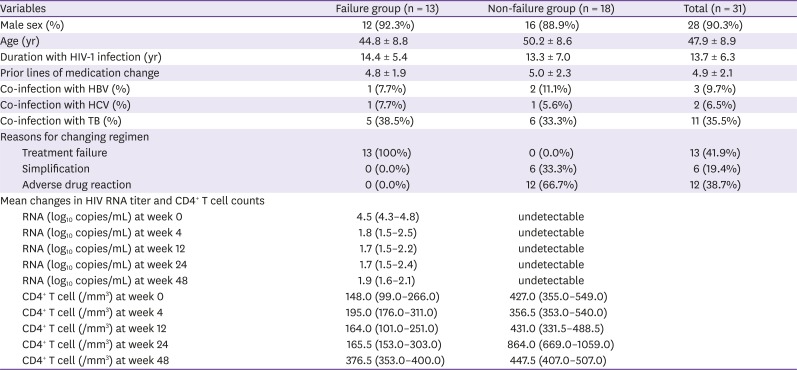
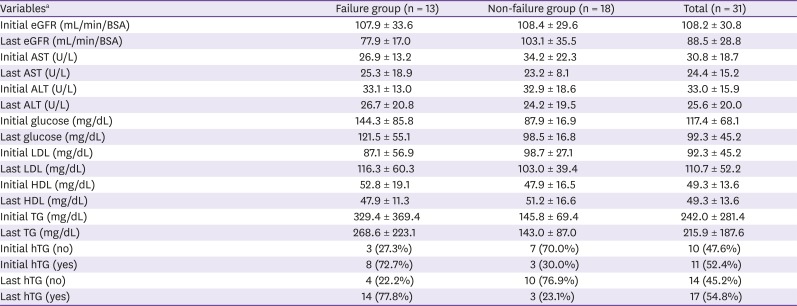
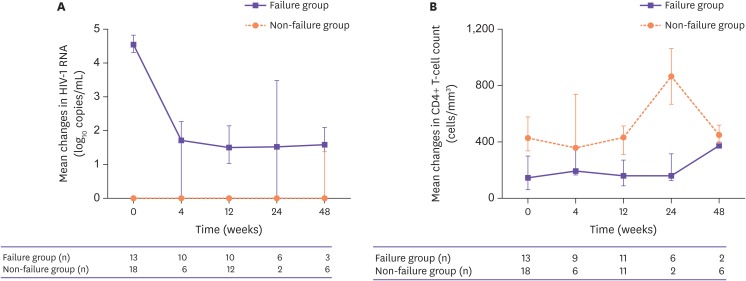




 PDF
PDF ePub
ePub Citation
Citation Print
Print



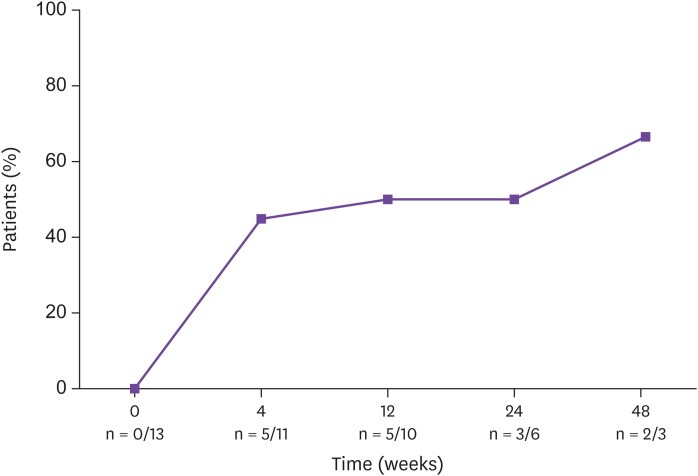
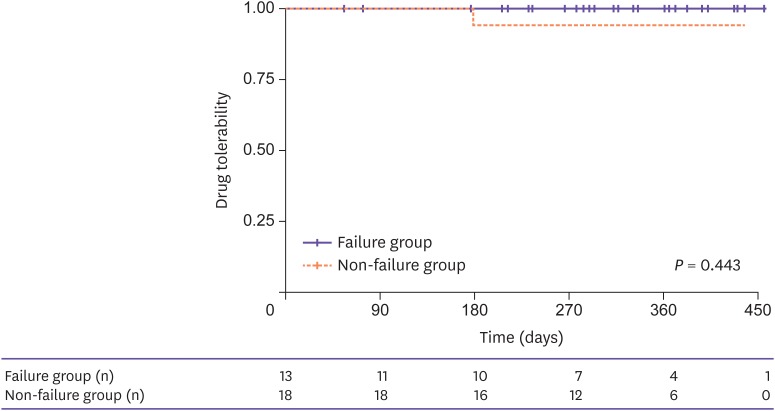
 XML Download
XML Download